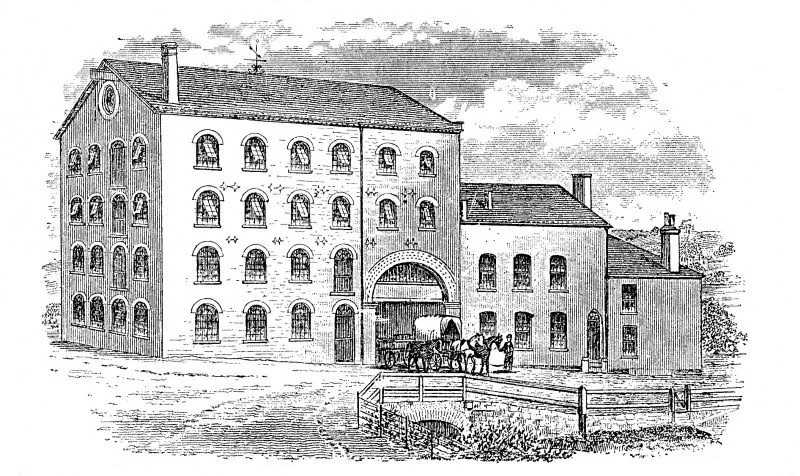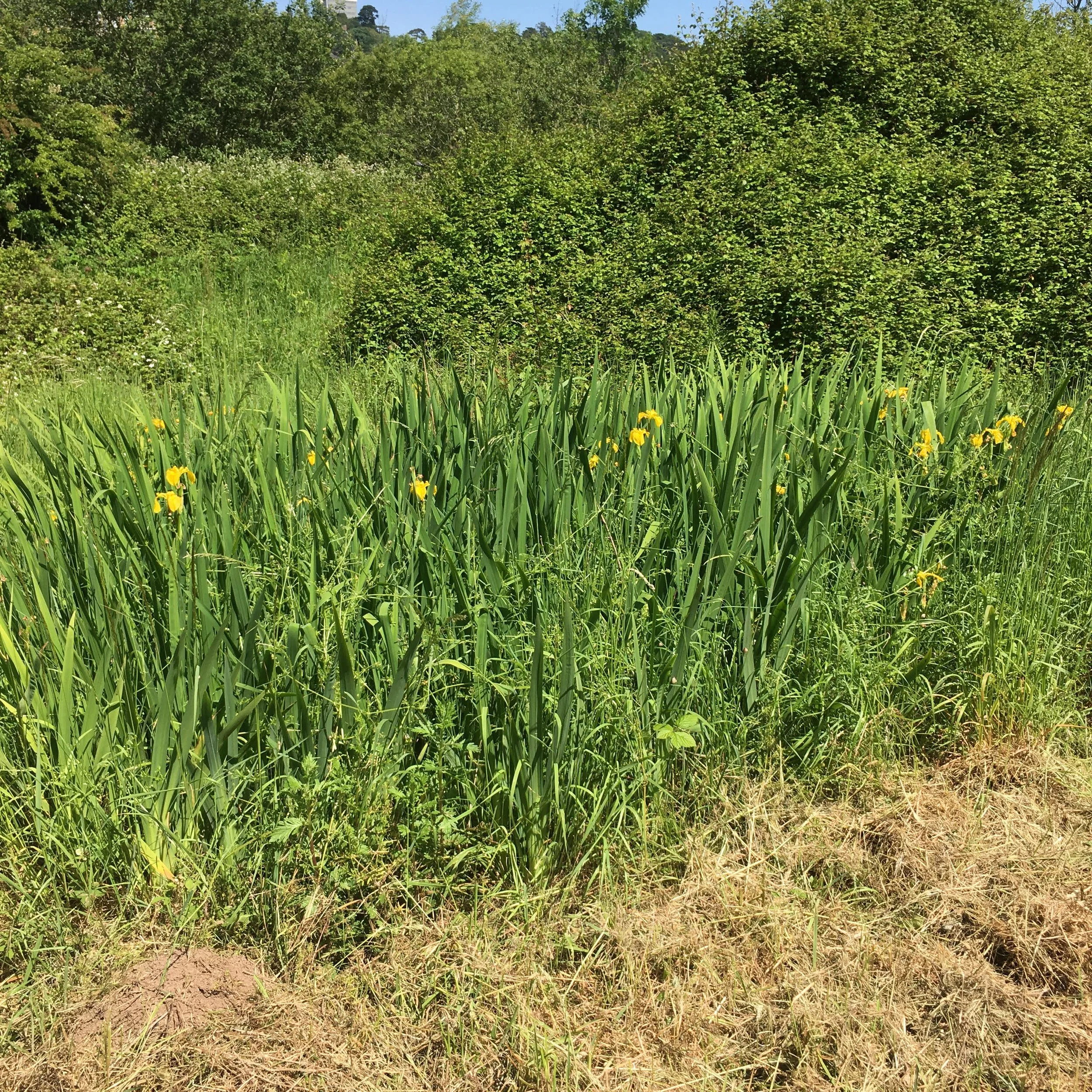Searching for Exwick Mills
By Jill Ashby, Paper & Print project research volunteer
I decided that walking around Exwick would give me more of a sense of the original layout of the mills there. I read a few bits of history that mentioned the mills but there seemed to be some confusion about their exact layout.
There is still a large mill building in Exwick that I presume was the one known as Exwick Upper Mills. It is located just outside of the main village on St Andrew’s Road, the lane that connects Exwick with Cowley.
There has been a water mill on this site since the eleventh century, it is thought to be the first to harness the power of the River Exe and was mentioned in the Domesday Book.
The current building was built by the Mallet family in 1886 and incorporated an old Manganese mill that was known as Middle Mills. On the south wall of the mill, facing Exwick, can be found a plaque that states
"Exwick Mill, re-built by W. R. Mallett AD 1886 on the site of mills worked by the Benedictine monks of the priory at Cowick AD 1325. Alfred Bodley engineer, Brock and Ash builders."
These mills in their time have had many uses, grist, fulling and flour mills and I have seen one mention of a paper mill existing on this site in 1673, along with 8 fulling mills.
When his father died William Richard Mallet became solely in charge of the mills and in 1903 he built Hamlyn’s House across the road as the mill house for his family to live in. The stone gate posts are made of part of the old Exe Bridge.
In 1982 the mill buildings were sold to the current owner for £53,000 and he has been in the process of renovating it practically single handed ever since. Several years ago he used to organise parties and gigs for charitable causes in the garden and the ground floor of the building and I went to a couple back then.
Next to the mill garden is a footpath that takes you down to the river and what is now known as the Flow Orchard in the Valley Park. Could these flags that I passed, that grow in ponds or on marshy ground be evidence of the route of the leat which ran down from Upper Mills to Lower Mills. This 1½ mile long leat that ran from opposite Duryard Weir, was cut through solid rock in places, and in other places dry stone walling was used to support the banks.
Walking back towards Exwick Church along St Andrew’s Road, you pass on the left a newish development of houses called Riverside Drive, these are built on the site of the Paper Mills.
The Paper Mills were built over the leat, close to Lower Mills on the site of an old fulling mill, by Thomas Bedford Pim. In 1805 he applied for fire insurance for the building.
A fire at Pim's mill broke out on December 4th 1809, which was investigated as arson, with Mr Pim as the possible suspect; in the event, it was not proven. The Flying Post reported the event
"On Monday evening, about six o'clock, a most alarming fire broke out in the extensive paper-mill belonging to Mr. Thomas Pim, at Exwick, near this city, which raged with such fury, that the whole of the building, together with an immense stock of paper, were entirely destroyed before the fire could be got under. The flames were prodigious, and the sight awfully grand and tremendous, flakes of fire and bundles of paper were carried blazing into the air, threatening destruction to the whole village, but which was providentially preserved with the exception of two joining cottages. The premises were insured to a large amount, but we hear very inadequate to the loss sustained."
Pim quickly rebuilt the mill and resumed paper manufacturing, until 1813 when he became insolvent and was petitioned for bankruptcy; events took another turn, when he was prosecuted by the Hope Insurance Co for a fraud related to the fire in 1809. It was alleged he committed perjury, having taken out two mortgages on the property without telling the company. Pim was found guilty on 31st March and awaited sentencing. On December 1st 1814, he was sentenced to serve 2 years in the Devon County Gaol.
By 1817 Pim was bankrupt and the mills were leased to a succession of paper makers until they were closed in 1864 and the building became a flour mill and finally the Exwick steam laundry which was demolished in 1980.
At the back of Riverside Drive is Exwick House, built around 1820 as the Mill House for the paper mills, now it is apartments. The house can be seen from the river and the Valley Park but the extensive mill buildings that surrounded it are hard to imagine.
Lower Mills were probably about 50 meters downstream from the Paper Mills with various extra buildings that crossed St Andrew’s Road and continued up Exwick Hill, including an original Mill House called Exwick Manor and many mill workers' cottages.
Anthony Gibbs had bought land by the leat and in Exwick village, including the Manor and Hermitage cottage and built a new woolen mill complex for spinning and weaving in 1786. He soon ran out of money and had to borrow from his father, Banfill and others. He finally left the country and Banfill continued to run the Mills until his retirement in 1828.
Opposite Riverside Drive is a stone wall thought to be part of the wall that surrounded Exwick Manor and on the corner of Exwick Hill is a black and white building, all that remains of the original Manor and described in a sale as ‘an out house for stabling’. In its more recent history it has been The Lamb Inn, the Post Office, The Village Inn and is now flats.
Alexander Jenkins, in his book, The History of Exeter, published in 1805, described the woollen factory :
"In this hamlet Edmund Granger and Samuel Banfill, Esqrs. have established a large woollen manufactory, and erected spinning machines, workshops, dye-houses, tenter grounds, &c.; also dwelling-houses for the manufacturers, an establishment which has greatly increased the number of inhabitants; here is Exwick House, once the residence of the family of Oliver, from whom it came by marriage to William Williams, M. D. of Exeter; it was the residence of his widow for many years, whose heirs sold it, with the Barton, to the present proprietors of the manufactory. It is now the residence of Samuel Banfill, Esq. the directing partner of that extensive concern."
The Manor was lived in by Samuel Banfill until in 1828 when he retired to The Hermitage, a cottage thought to date back to the twelfth century. The Manor House fell into disrepair and was probably demolished about 1860.
When Banfill retired Lower Mills were taken over by Robert Maunder who ran it as a woolen mill until 1859 when it was run as a woolen and flax mill by Treble and Son until 1861 when it was destroyed by fire for the second and final time with the loss of 40 jobs.
Back on St Andrews Road and walking towards St Thomas, on the left before the Church are a row of cottages originally known as Mill Cottages, they were built right next to the leat and when it was filled in the cottage owners took the opportunity to extend their kitchens over it. By the church is Station Road, originally a private road and bridge built by James Buller who realised the advantages of easy access to the railway. The building across Station Road from the church was a toll house built in 1853, and Buller charged all but the ‘labouring classes’ to use his road.
Walking back to St Thomas I stopped for a drink in The Thatched House and tried to imagine whether paper workers would stop off there for a drink on their way home. Since then I have found that there was another pub much closer to the mills in one of the mill cottages. It had a reputation for after hours drinking, but more of that next time.
Photos by Jill Ashby or from Exeter Memories website.















